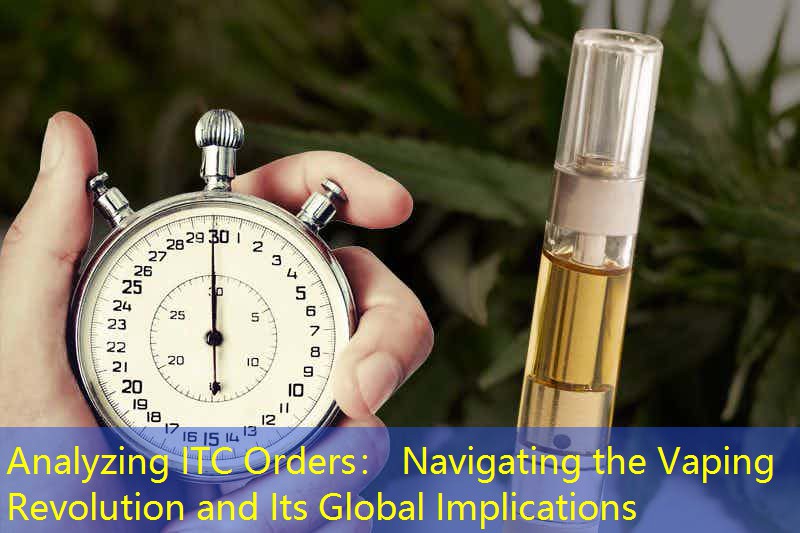ITC Order on Vaping: An Analytical Perspective
The landscape of tobacco and nicotine products is undergoing seismic shifts, driven largely by the rise of vaping and e-cigarettes. In recent times, the U.S. International Trade Commission (ITC) has taken a more pronounced stand on the vaping industry, issuing various orders targeting specific products and the companies behind them. This article explores the implications of these ITC orders on the vaping market, regulatory frameworks, and consumer behaviors. Through examining the ITC’s actions, we aim to paint a comprehensive picture of the vaping ecosystem amid increasing scrutiny.
The Rise of Vaping: A Transformative Influence
Vaping has emerged as one of the most significant trends in nicotine consumption over the past decade. Characterized by the use of electronic devices to inhale aerosolized liquid, vaping products have gained popularity among both smokers seeking alternatives and young adults attracted by flavored options. This transformative influence has led to debates around health, regulation, and commercial viability.

Understanding the ITC’s Role
The U.S. International Trade Commission plays a crucial role in trade regulation and has purview over unfair trade practices. Its mandate includes the investigation and resolution of patent infringement, dumping, and intellectual property violations. The ITC’s vigilance has intensified in light of growing concerns over the vaping industry, particularly regarding the safety of products and compliance with import regulations.
Key ITC Orders Impacting the Vaping Industry
In recent years, the ITC has issued several orders directed at specific vaping products and manufacturers. These orders often stem from patent disputes or claims of unfair competition. For instance, in 2020, the ITC ruled against Major vape manufacturers due to intellectual property infringement, resulting in product bans and modifications. Such rulings not only affect the concerned companies but can also drive shifts in market dynamics and consumer availability.
Health Concerns and Regulatory Scrutiny
One of the main catalysts for the ITC’s actions is the heightened scrutiny surrounding the health effects of vaping. Regulatory bodies like the FDA have implemented tighter controls on the marketing and sale of vaping products, especially those appealing to younger demographics. The ITC’s orders often align with these health initiatives, aiming to ensure that products meet safety standards and responsible marketing practices.
Case Study: ITC Order Against Juul Labs
Juul Labs epitomizes the complexity of the vaping industry and its interactions with regulatory bodies. The company faced multiple lawsuits regarding patent infringements attributed to its devices. The ITC’s ruling against Juul highlighted the intricate relationship between intellectual property rights and public health concerns, showcasing how legal outcomes can have far-reaching effects on overall market trends.
Market Shifts and Consumer Choices
The repercussions of ITC orders extend beyond individual companies. As brands alter their product lines in response to rulings, consumers are left to navigate a changing market landscape. The reduction in options for certain types of vaping products can push consumers towards less regulated alternatives or even lead them back to traditional tobacco products, raising new public health concerns.
The Global Context of Vaping Regulation
While the ITC primarily focuses on the U.S. market, the implications of its orders resonate globally. Many countries are grappling with how to regulate vaping, drawing from the U.S. experience. This global interconnectedness means that ITC rulings can influence international policy discussions, shaping the regulatory environment for vaping worldwide.
Impacts on Innovation and Development
Innovation is crucial in the vaping industry, particularly as manufacturers strive to create safer products and comply with emerging regulations. ITC orders can either foster innovation by forcing companies to improve their offerings or stifle it by creating barriers to entry for new players in the market. This duality raises questions about the future direction of product development within the vaping sphere.
Key Comparisons: Vaping vs Traditional Smoking
| Aspect | Vaping | Traditional Smoking |
|---|---|---|
| Health Risks | Unknown long-term effects; fewer toxic substances | Known health risks; combustion products |
| Age Demographics | Popular among younger adults; targeted marketing | Historically targeted older adults |
| Regulatory Status | Varies by region; increasingly regulated | Heavily regulated in most areas |
| Consumer Options | Wide variety of flavors and devices | Largely confined to tobacco products |
Questions and Answers
What is the primary purpose of the ITC’s orders related to vaping?
The primary purpose of the ITC’s orders related to vaping is to address issues of unfair trade practices, specifically regarding intellectual property rights and patent infringements. By issuing these orders, the ITC aims to maintain a level playing field in the market while ensuring that consumer safety is prioritized through compliance with health standards.
How do ITC orders influence consumer behavior in the vaping market?
ITC orders can significantly influence consumer behavior by altering the availability of certain products and brands. If popular items are banned or modified due to legal disputes, consumers may seek alternatives, which could lead them to unregulated or less safe options. Additionally, the perception of product safety is often affected by regulatory scrutiny, which can shift consumer preferences accordingly.
What are the broader implications of vaping regulation on global markets?
The broader implications of vaping regulation, especially driven by ITC actions, can lead to a ripple effect in global markets. As countries observe the regulatory environment in the U.S., they may choose to adopt similar measures or adjust their own policies regarding vaping. This interconnectedness can impact international trade relations and the availability of vaping products across different regions.







